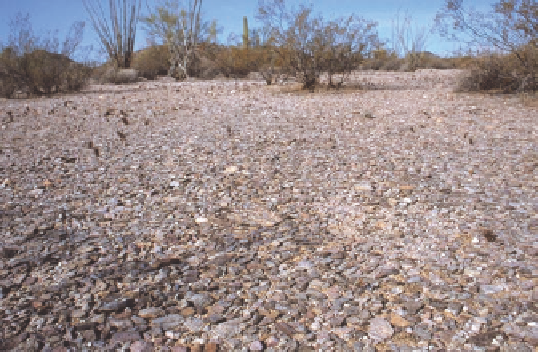Geoscience Reference
In-Depth Information
bottom of the clasts. Clays within the sediment subsequently
swell and shrink with wetting and drying over time, respec-
tively, causing the rock clasts to ride upward. Salt crystalliza-
tion within the sediment probably also plays a role in this lifting
process. With the addition of progressively more dust, the zone
of accumulation below the clasts thickens further, forcing the
pavement zone even higher and producing a smoothing effect
on the landscape. This thickened dust zone, which is classified
as a form of soil A horizon, is interesting in and of itself because
it contains microscopic pores called vesicles. Desert pavements
are usually a mix of dark colors, collectively referred to as
des-
ert varnish
, which consists of fine clays and bacteria that coat
rock surfaces over many decades.
Another form of eolian deposit is called
loess
(a German
word that, in the United States, is usually pronounced “luss”),
which consists of fine-grained, windblown silt. Loess is typi-
cally highly calcareous (as much as
∙
40% CaCO
3
) and yellow-
ish-tan in color (buff-colored). Loess often originates within
the same region as the sand that forms dune fields. Given that
silt can be carried far in the air by suspension, however, it is
sorted out from the sand and subsequently deposited great dis-
tances from its original source, leaving the dune fields behind
(Figure 18.24). Loess also originates in stream valleys after silt
is deposited on floodplains during floods. A great deal of loess
Figure 18.22 Desert pavement.
(a) A typical desert pavement
in the southwestern United States. Note the very coarse texture
of this surface.
leaving a coarse lag at the surface that could not be moved by
the wind.
As a result of detailed research, it is now believed that des-
ert pavement forms in association with dust deposition rather
than deflation (Figure 18.23). This development occurs because
dust accumulates on the coarse-textured desert surfaces and
settles in the gaps between the rock clasts when the sporadic
rains move it downward. In the early phase of pavement devel-
opment, the eolian sediment forms a crust that adheres to the
Windblown silt.
Loess
Figure 18.23 Formation of desert
pavement.
Desert pavement forms
through the process of dust deposi-
tion. In Phase 1, fine dust falls between
coarse rock clasts and forms a crust.
As time passes (Phase 2) and more
dust accumulates, the crust thickens,
soil vesicles form, and rocks move up-
ward by a combination of shrink/swell
and salt crystallization. In Phase 3, fines
move down columnar ped boundaries
and horizontally along platy structures.
The soil thickens further and the clasts
move further upward. (
Source
: K. An-
derson, S. Wells, R. Graham. “Pedo-
gensis of Vesicular Horizons, Cima
Volcanic Field, Mojave Desert, Califor-
nia.”
Soil Science Society of America
Journal
2002; 66:878-887. Reprinted
by permission, ASA, CSSA, SSA.)
Phase 1
Phase 2
Phase 3
Windblown dust
falls, is carried
down between
rock clasts, and
forms crust.
Dust layer thickens,
soil vesicles form,
rocks move upward
by shrink/swell and
salt crystallization.
Fresh eolian dust moves down
columnar ped boundaries and
horizontally along platy
structures. Soil further
thickens, forcing clasts higher.
Eolian sediment
Vesicular soil
Direction of sediment movement
Columnar ped boundary
Platy structure
Basalt bedrock or clasts
B horizon












































































